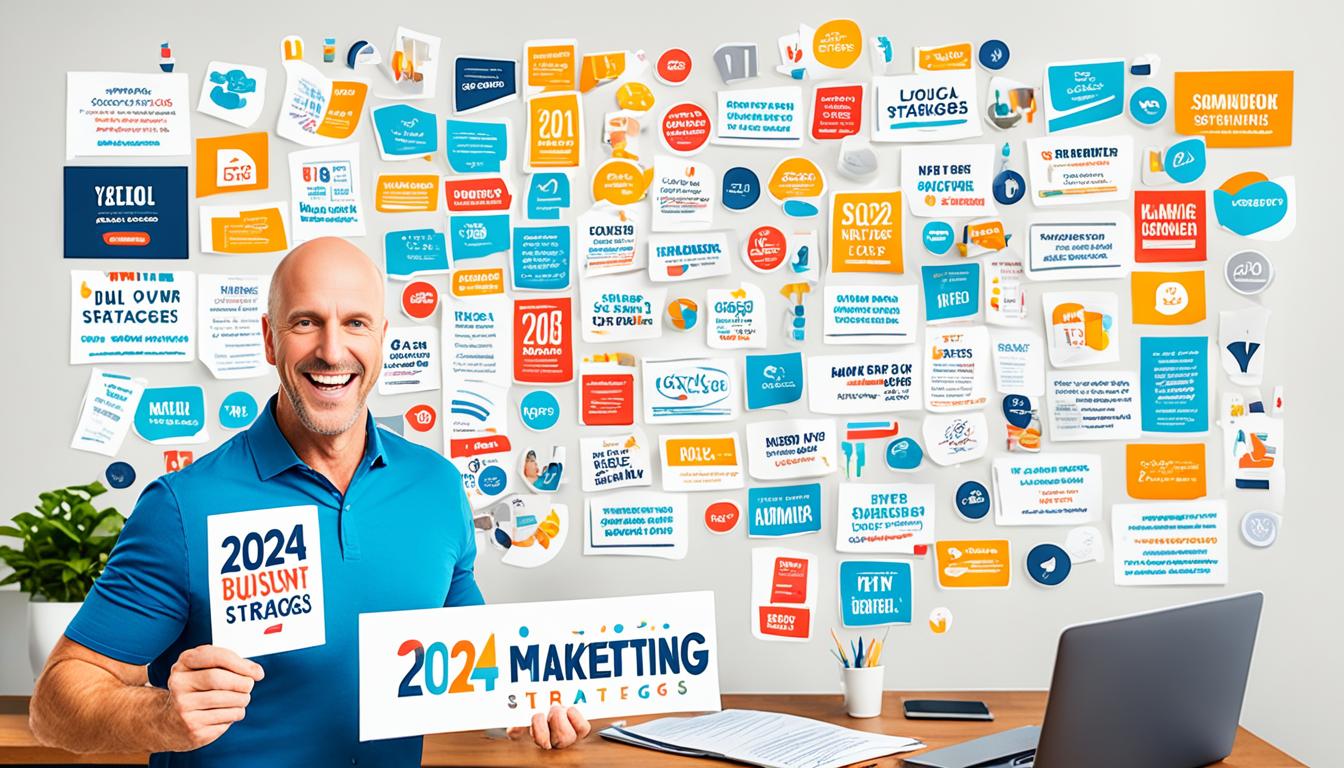Agile marketing is all about moving fast on projects by working in short periods, known as sprints. This approach is open to learning from failures. It also puts a strong focus on working together with customers. Studies have shown that companies adopting Agile techniques report a revenue boost of 20-40%. They also manage to get their ideas to market faster.
Key Takeaways:
- Agile marketing is a strategic approach that prioritizes quick execution and continuous improvement.
- It embraces failure and prioritizes customer-focused collaboration.
- Agile marketing has been proven to increase revenue and reduce time to market.
- Organizations using Agile marketing have seen significant business benefits.
- Implementing Agile marketing requires choosing the right methodology and having a clear strategy.
What is Agile Marketing?
Agile marketing is a way of thinking that puts high-value tasks first, working in quick bursts. It revolves around quick changes, learning from actual results, working well with customers, and being ready to shift directions.
It picks up ideas from the Agile methodology, initially for software development. Key values include learning from real results rather than just opinions, working closely with customers rather than staying in separate groups, and favoring flexible, step-by-step campaigns over one big launch.
With Agile marketing, teams can quickly respond to new market trends and what customers want. This leads to better campaign results and happier customers. It’s all about improving continually and making choices based on data.
Teams use small, clear tasks known as user stories to manage projects. They sort these stories by what customers and the business need most. This helps deliver valuable results fast and well.
Agile marketing teams work in sprints, which last about two to four weeks. When a sprint ends, they review how things went, use feedback, and adjust their plans. This repeating cycle helps refine their marketing efforts over time.
Working together well is key in Agile marketing. Instead of being divided, different team members work together towards shared goals. This teamwork leads to a better grasp of what customers need and quicker decisions.
Being able to adapt is also crucial in Agile marketing. Campaigns need to be flexible to change as new information or market trends emerge. Through constant testing and learning, Agile marketers fine-tune their campaigns for the best results.
In short, Agile marketing is about quickly adapting, working well together, and making constant improvements. By using Agile methods, marketers can do better and adjust to changes in the marketing world.
The Agile Marketing Process
Agile marketing teams use methods like Scrum and Kanban to succeed. Scrum is known for its sprints, helping teams finish work fast. It includes planning, daily stand-ups, reviews, and retrospectives.
Kanban focuses on visualizing the workflow and limiting work-in-progress (WIP). Teams visualize tasks to manage and prioritize them well. Kanban’s approach helps teams improve their work constantly.
Both Scrum and Kanban stress teamwork and collaboration in marketing. They enable team members to share expertise and insights. This teamwork ensures high-quality outcomes through combined strengths.
Comparison between Scrum and Kanban
| Methodology | Key Features |
|---|---|
| Scrum |
|
| Kanban |
|
Scrum and Kanban, while distinct, both suit Agile marketing’s principles. They push for adaptive marketing, focusing on the customer and ongoing enhancement.
Adopting Agile methods like Scrum and Kanban can transform your marketing. It boosts efficiency, fosters teamwork, and helps adapt to market changes smoothly.
Examples of Agile Marketing Success
Agile marketing is a top strategy for companies to adapt and thrive in today’s quick market. Many well-known companies have used Agile marketing and seen great success. Let’s look at some cases where Agile marketing made a big difference in growth.
DoorDash
During the pandemic, DoorDash showed exceptional flexibility. They changed their marketing to meet new customer needs quickly. This led to a 226% rise in revenue. They launched #OpenforDelivery, delivered COVID test kits, and added new customer-friendly features.
Site Strategics
Site Strategics, a digital marketing agency, refreshed its marketing with Agile. Agile methods led to better campaign delivery and results. They saw more efficiency, quicker market times, and better customer chats.
Carsurfing
Carsurfing, a new car rental service, used Agile marketing to appeal to its audience’s changing likes. Agile strategies helped them quickly improve their campaigns. This boosted customer interest, more conversions, and better customer loyalty.
Teradata
Teradata, a provider of data analytics and marketing solutions, moved to Agile marketing. This switch made their marketing more targeted and personal. They saw more customer interest and a bigger return on marketing investments.
CafePress
CafePress, an online shop for custom products, improved its marketing with Agile. Agile practices got them to market faster, increased customer happiness, and better business results. They could swiftly react to market changes and tweak their campaigns for customer needs.
Dell
Dell adopted Agile marketing to keep leading in the tech world. Agile let them adapt quickly to new markets and customer wishes. Dell saw better campaign results, more customer interest, and stronger brand loyalty.
These stories show how Agile marketing works well in different sectors. From food delivery to tech firms, Agile marketing is a key strategy for growth and adjusting to quick market changes.
Agile Marketing Agencies
Businesses can gain a lot by working with Agile marketing agencies. These agencies are experts in making businesses more adaptable and quick. They help speed up the delivery process. They also make companies more competitive in today’s fast-changing marketing world. They provide many services to help businesses on their Agile marketing path.
Ironpaper stands out as a top Agile marketing agency. They have a solid history of running successful Agile marketing campaigns for their clients. Ironpaper aids businesses in creating a strong digital strategy. This strategy matches their goals, ensuring great impact and investment returns.
Weidert is known for helping businesses use Agile marketing tactics well. They specialize in project management and making workflows smoother. This leads to better teamwork and efficient campaigns. Weidert’s direct approach helps businesses tackle Agile marketing’s challenges.
Kanbanize is famous for its workflow optimization knowledge. They offer tools to help businesses see their workflow clearer, set limits on work in progress, and be more productive. Kanbanize’s methods help teams work smarter, adjust to changes, and get better outcomes.
Working with Agile marketing agencies like Ironpaper, Weidert, and Kanbanize can really help businesses stand out. These agencies have a lot of knowledge, experience, and tools for Agile marketing. They support businesses in becoming more agile in their marketing efforts.
Implementing Agile Marketing
Agile marketing needs deep knowledge and a strong plan. It includes sprints, meetings, boards for tracking, and teamwork across different functions.
First, pick the right Agile marketing method for your team’s goals. It could be Scrum, Kanban, or another approach. The right choice directs your team’s efforts and helps bring success.
Then, make a detailed plan for implementing it. This plan should list steps, times, and results expected at each stage. Doing this keeps your team focused and able to monitor success.
Hold stand-up meetings regularly during sprints. These ensure teamwork and clear communication. They let the team share updates, solve problems, and adjust plans to keep on target.
Using project tracking boards is key to Agile marketing. They show tasks’ status in a clear way for all. This visibility improves workflow and makes everyone accountable for their part.
Teamwork is at the heart of Agile marketing. Make sure your team is ready for changes and can work across different areas. Good working together and communication are key to making Agile marketing work.
Benefits of Agile Marketing
Agile marketing helps businesses thrive in today’s quick-changing market. It lets organizations grow, compete better, and give great customer service by using Agile methods.
1. React Swiftly to Changes in the Market
Agile marketing lets teams quickly adjust to new market trends and customer needs. By working in short cycles, they can change their plans fast. This keeps them ahead and helps grab the best chances.
2. Rapid Testing and Optimization of Campaigns
The Agile approach pushes for ongoing testing and improving of campaigns. Teams use data and feedback to see what’s working. This helps them tweak their strategies for better results and investment returns.
3. Opportunity to Try New Ideas
Agile marketing gives teams a chance to try new things. They work together to find new solutions and big breakthroughs. This can greatly help the business grow and succeed.
4. Collaboration and Data-Driven Decision Making
Agile marketing boosts teamwork and helps break down barriers. Data guides decision-making, aligning efforts with what customers want and business goals.
5. Continuous Improvement
Agile marketing is about getting better all the time. Teams learn from what works and what doesn’t. They keep improving, which makes their marketing stronger.
6. Extension to Other Departments
Agile marketing’s benefits reach beyond just the marketing team. It promotes teamwork across the company. This makes the whole organization more flexible and united.
By adopting Agile methods, companies can transform their marketing. This leads to big wins in the ever-changing business world.
Is Agile Marketing Right for Your Business?
Agile marketing brings big benefits in today’s fast world. It focuses on being quick, adaptable, and working together. But, is it a good fit for your company? Let’s look at what you need to think about.
Uncertainty in Work
Does your business deal with constant change? Agile marketing might give you an edge. It lets your team quickly shift gears based on new trends and customer needs. With agile, you can keep up and respond swiftly to the unknown.
Team Dynamics and Collaboration
Agile marketing is all about teams working closely. It combines different talents aiming for the same goal. If your company likes teamwork, open talks, and values different views, agile marketing could make your team stronger and more united.
Speed and Adaptability
Need to move fast in response to changes and customer demands? Agile marketing is likely a good match. Teams work in short bursts to achieve great things quickly. This way, you can tweak and perfect your campaigns on the go, using data to guide you towards success.
Assessing Team Suitability
Thinking about trying agile marketing? First, see if your team is up for it. Agile works best when everyone is ready for change, willing to work together, and eager to get better. Check if your team’s mindset and skills fit with agile before jumping in.
Agile marketing has a lot to offer, but it’s not for everyone. If your business doesn’t like changes or moves slowly, a traditional approach might be better. Make sure to think about what makes your business unique when deciding if agile marketing is the way to go.
Considerations for Agile Marketing Transformation
Starting an Agile marketing transformation brings several key points to think about. It’s important to check if the team is ready for change, sure they can work across different areas, and if the team size is right. Also, picking the best Agile method is key for a successful change.
1. Team’s Willingness to Change
Switching to Agile marketing means changing how we think and work. We need to see if the team is open to new ways. Clear and honest talks are crucial. They help everyone see the good and tough parts of adopting Agile. Making a culture of ongoing learning helps teams move through the change smoothly.
2. Cross-Functional Capabilities
An Agile marketing team does well when it collaborates and has different skills. Check the team’s abilities and make sure skills from many marketing areas are included. This strategy lets the team cover all parts of marketing well. Finding skill gaps early lets you plan better training.
3. Agile Methodology Selection
Different Agile methods, like Scrum, Kanban, and Lean, suit different needs. It’s crucial to choose the right one. Think about how big the team is, how complex the work is, and how much flexibility is needed. Scrum fits smaller teams that make quick changes well. Kanban or Lean might work better for bigger teams with ongoing work.
Here’s a table showing key points of each method:
| Methodology | Key Features |
|---|---|
| Scrum |
|
| Kanban |
|
| Lean |
|
4. Team Size
The Agile marketing team’s size makes a big difference. Smaller teams move quickly and coordinate easily. But bigger teams bring more ideas and expertise, even if they need more planning and talks. Figuring out the best team size helps in working well together and reaching high goals.
Thinking about these things during an Agile marketing transformation sets organizations up for success. Being honest about what the team can do and their willingness to try new things is essential. With the best method, a teamwork-driven attitude, and support, Agile marketing can change how companies handle marketing and lead to lasting success.
Agile Marketing and Business Benefits
Adopting Agile marketing can make businesses perform better. It boosts productivity and results. Here are some important benefits:
Improved Collaboration
Agile marketing creates a teamwork culture. It removes barriers in teams and promotes working together. Teams work in cycles and have regular meetings.
This way, they share ideas, align their goals, and solve problems together. This leads to better efficiency and synergy.
Faster Project Delivery
The Agile method helps marketing teams work in short bursts called sprints. This lets them finish projects quickly and adjust to market changes fast. They focus on the most valuable work and use feedback to be more efficient.
This cuts down the time to launch and speeds up their work.
Increased Autonomy for Marketing Teams
Agile marketing lets teams own their projects and make smart choices. It supports using data to make decisions and pushes for independence. This method makes teams feel responsible and accountable.
They can change their plans, try new ideas, and improve their work. This helps them get the best results.
Optimized Results and Continuous Improvement
Agile marketing is about getting better all the time. Teams learn, test, and tweak their campaigns using feedback and data. This process helps marketers find the best strategies, make smart choices, and refine their methods.
By always learning and adapting, businesses can stay competitive. This helps them make the most of their marketing.
Enhanced Organizational Agility and Efficiency
Agile methods aren’t just for marketing. They can improve other departments too. When the whole company uses Agile, it becomes more flexible, processes get smoother, and teams work better together.
This company-wide approach boosts adaptability, speed, and innovation. It leads to better efficiency and business success.
Agile Marketing and Business Benefits
| Benefits | Description |
|---|---|
| Improved Collaboration | Encourages teamwork, communication, and knowledge sharing. |
| Faster Project Delivery | Enables swift response to market demands and reduces time-to-market. |
| Increased Autonomy for Marketing Teams | Empowers teams to make data-driven decisions and take ownership of their work. |
| Optimized Results and Continuous Improvement | Prioritizes learning, testing, and optimization to drive better results over time. |
| Enhanced Organizational Agility and Efficiency | Promotes Agile practices company-wide, streamlining processes and improving collaboration. |
Conclusion
Agile marketing is about acting fast, focusing on the customer, and always getting better. It helps businesses make more money and get their products to customers quicker. Being able to change quickly lets companies stay ahead and perform better than others.
Choosing the right Agile method is key to success. It could be Scrum or Kanban. But what’s most important is having a plan and talking openly. It’s also crucial to welcome change and work together closely.
Agile marketing doesn’t just make marketing teams better. It also helps the whole company work better together. By using data to make decisions, companies become more flexible. This leads to improved results in all areas.
In the end, Agile marketing helps businesses be more responsive, focused on customers, and efficient. By following Agile ways, companies can face the fast-changing marketing world more successfully.




